
Catalog excerpts
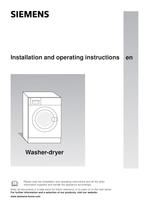
SIEMENS Installation and operating instructions Washer-dryer Please read the Installation and operating instructions and all the other information supplied and handle the appliance accordingly. Keep all documents in a safe place for future reference, or to pass on to the next owner. For further information and a selection of our products, visit our website: www.siemens-home.com en
Open the catalog to page 1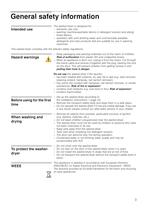
General safety information The washer-dryer is designed for: – domestic use only. – washing machine-washable fabrics in detergent solution and drying these fabrics. – operation with cold drinking water and commercially available detergents and care products that are suitable for use in washing machines. Intended use This washer-dryer complies with the relevant safety regulations. – Keep packaging and packing materials out of the reach of children. Risk of suffocation from plastic film and collapsible boxes. – When an appliance is worn out, unplug it from the mains. Cut through the mains...
Open the catalog to page 3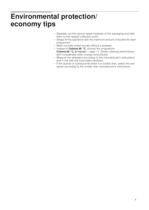
Environmental protection/ economy tips – Separate out the various waste materials of the packaging and take them to the nearest collection point. – Always fill the appliance with the maximum amount of laundry for each programme. – Wash normally soiled laundry without a prewash. – Instead of Cottons 90 °C, choose the programme Cottons 60 °C, X Intensiv → page 11. Similar cleaning performance with considerably lower energy consumption. – Measure the detergent according to the manufacturer's instructions and in line with the local water hardness. – If the laundry is subsequently dried in a...
Open the catalog to page 4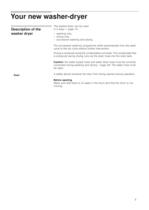
Your new washer-dryer Description of the washer dryer The washer-dryer can be used in 3 ways → page 15: – washing only, – drying only, – successive washing and drying. The successive wash-dry programme shifts automatically from the wash cycle to the dry cycle without further intervention. Drying is achieved using the condensation principle. The condensate that is produced during drying runs via the drain hose into the drain tank. Caution: the water supply hose and water drain hose must be correctly connected during washing and drying → page 26. The water hose must be open. Door A safety...
Open the catalog to page 5
Control panel Indicator lamps Indicate the settings that have been selected for: – Spin speed: $ - 1400 rpm (depending on the model). – Washing options / signal. Display panel Shows the settings that have been selected (e.g. spin speed, drying time), the progress of the current programme and the programme status. Programme progress N ' B ˆ ! Auxiliary displays 0 ! ?7 Indicator lamps @ kg Prewash, main wash, rinse, final spin, drying.kg Finished in Time, Start of the program, childproof lock, fluff removal cycle , recommended load. Display Buttons Washing and drying options → page 13 – Spin...
Open the catalog to page 6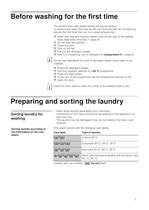
Before washing for the first time The washer-dryer was tested before leaving the factory. To remove any water that may be left over from the test, do not load any laundry the first time that you run a wash programme. Make sure that the transport safety bolts on the rear of the washerdryer have been removed → page 24. Do not load any laundry. Close the door. Turn on the tap. Pull out the detergent drawer. Add ½ a measuring cup of detergent to compartment II → page 9. i Do not use detergents for wool or delicates (these cause foam to be created). Close the detergent drawer. Turn the program...
Open the catalog to page 7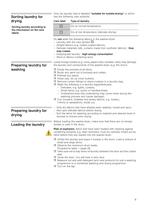
Sorting laundry for drying Sorting laundry according to the information on the care labels Only dry laundry that is labelled "suitable for tumble-drying" or which has the following care symbols: Care label Type of laundry a Dry at normal temperature. ` Dry at low temperature (delicate drying). Do not wash the following fabrics in the washer-dryer: – Laundry with the care symbol b. – Airtight fabrics (e.g. rubber-coated fabrics). – Delicate materials (silk, curtains made from synthetic fabrics) - they may crease. – Dripping-wet laundry - high energy consumption – Wool or fabrics containing...
Open the catalog to page 8
Detergents and Care Products The detergent drawer is divided into three compartments Detergent drawer Compartment I : detergent for prewash. Compartment II : detergent for main wash, Compartment i : Liquid additives, such as starch or fabric softener. Additives are automatically dispensed during the final rinse cycle. – Do not exceed the maximum capacity, otherwise compartment i may be emptied too early. – Dilute viscous additives with water to prevent blockages. I II i Liquid detergent insert: this must be folded down before liquid detergents are used. To do this: Pull out the detergent...
Open the catalog to page 9
Normally soiled laundry Measuring washing powder Set the programme. Do not select ! (Prewash) → page 13. Add all the detergent, according to the manufacturer's instructions, to compartment II of the detergent drawer. Heavily soiled laundry Set the programme. Select ! (Prewash) → page 13. Add 1/4 of the recommended amount of detergent to compartment I of the detergent drawer and 3/4 of the detergent to compartment II. Only use liquid detergent for the main wash cycle with no prewash. Measuring liquid detergent To do this: Add the recommended amount of detergent to a liquid detergent...
Open the catalog to page 10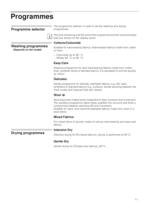
Programmes The programme selector is used to set the washing and drying programmes. Programme selector i Washing programmes (Depends on the model) The time remaining until the end of the programme and the recommended load are shown on the display panel. Cottons/Coloureds Suitable for hard-wearing fabrics, heat-resistant fabrics made from cotton or linen. – Coloureds up to 60 °C. – Whites 60 °C to 90 °C. Easy-Care Washing programme for less hard-wearing fabrics made from cotton, linen, synthetic fibres or blended fabrics. It is advisable to sort the laundry by colour. Delicates Gentle...
Open the catalog to page 11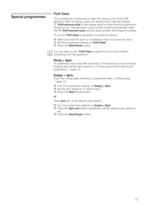
Fluff Clean Special programmes This programme is designed to clean the drying cycle of any fluff deposits. After 10 drying cycles, the washer-dryer uses the symbol 7 (Fluff removal cycle) in the display panel to show that this programme should be run. The electronic cycle counter is then automatically reset. The 7 (Fluff removal cycle) symbol goes out after the programme starts. To run the Fluff Clean programme, proceed as follows: Make sure that the drum is completely empty and close the door. Set the programme selector to Fluff Clean. Press the Start/Pause button. i You can also run the...
Open the catalog to page 12All Siemens Home Appliances catalogs and technical brochures
-
Freestanding Appliances
42 Pages
-
EZ977KZY1E
3 Pages
-
CM678G4S6B
3 Pages
-
HB672GBS1B
3 Pages
-
HB676GBS6B
3 Pages
-
EC9A5SB90
3 Pages
-
WM14XEH4GB
3 Pages
-
ET875FCP1D
2 Pages
-
ET651HE17E
3 Pages
-
Built-in Appliances Brochure
111 Pages
-
catalog 2016
79 Pages
-
Free-standing Appliances
46 Pages
-
Built in brochure
74 Pages
-
Freestanding Brochure
46 Pages
-
Ovens 2009
22 Pages
Archived catalogs
-
2022 Built-in Appliances
109 Pages
-
EX807LX67E
7 Pages
-
2014 Built-in Appliances
77 Pages
-
90004930205
36 Pages
-
9000755818
64 Pages
-
90006944392
30 Pages
-
90006502641
30 Pages
-
90006317281
28 Pages
-
90005805756
30 Pages
-
9000731775
23 Pages
-
90007104181
40 Pages
-
90005263871
140 Pages
-
9000650983
8 Pages
-
9000646020
24 Pages
-
9000645988
24 Pages
-
9000644401
40 Pages
-
9000644314
36 Pages
-
9000538106
31 Pages
-
9000523431
32 Pages
-
9000455265
148 Pages
-
9000443031
14 Pages
-
9000371475
24 Pages
-
Tumble Dryers 2009
7 Pages
-
Built-in Dishwashers 2009
16 Pages
-
Built-in Laundry 2009
7 Pages
-
Built-in Cooling 2009
20 Pages
-
Cooker Hoods 2009
18 Pages
-
Hobs 2009
9 Pages
-
Freestanding Washing 09
10 Pages
-
Freestanding Dishwashers 09
14 Pages
-
Freestanding Cooling 09
20 Pages
-
Smart Living 2009
16 Pages


















































